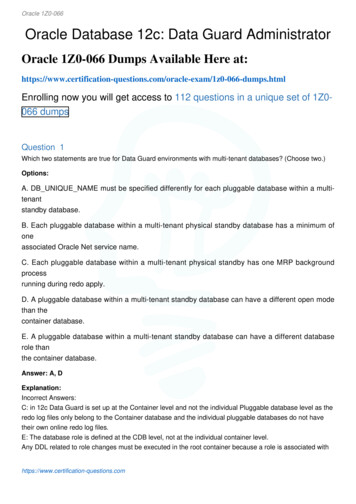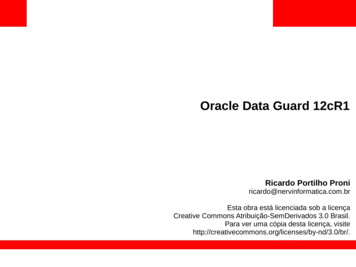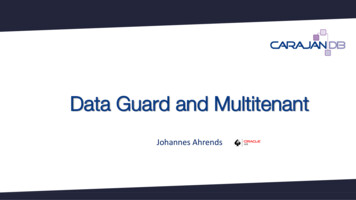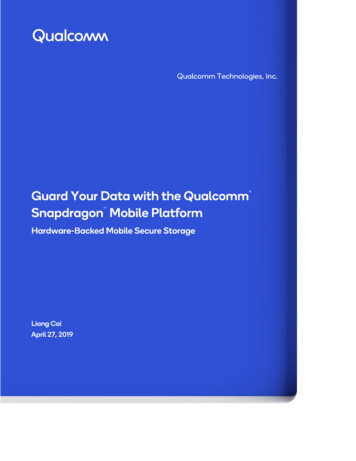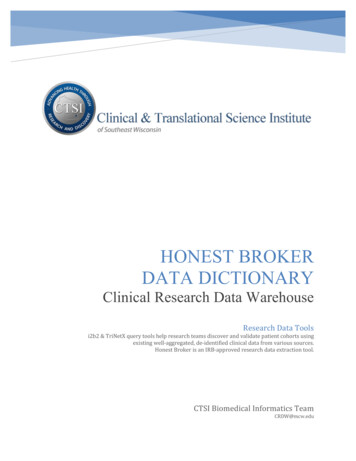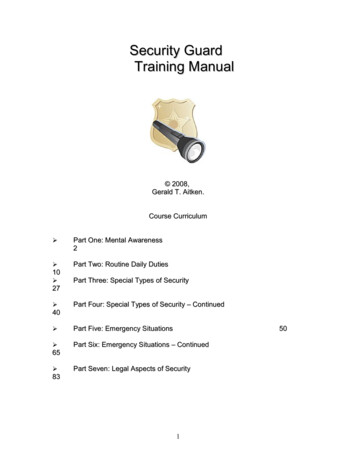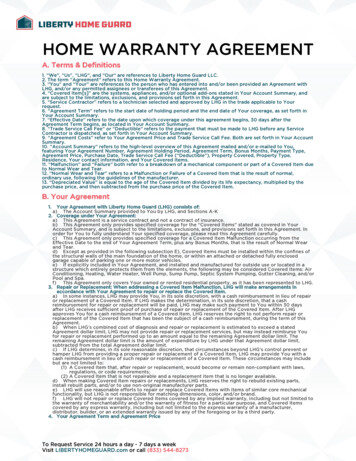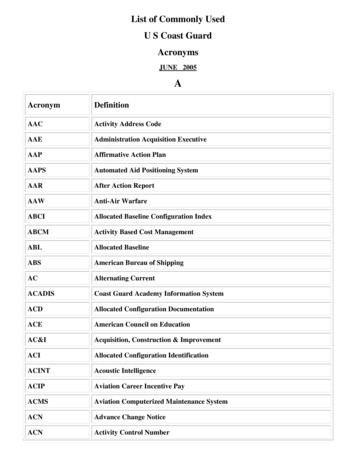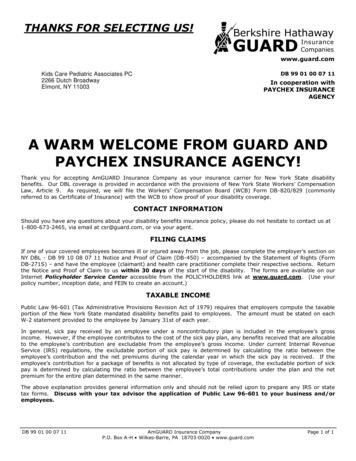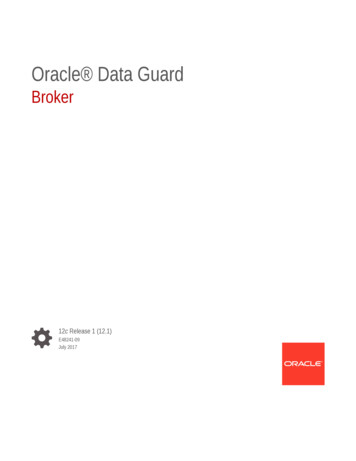
Transcription
Oracle Data GuardBroker12c Release 1 (12.1)E48241-09July 2017
Oracle Data Guard Broker, 12c Release 1 (12.1)E48241-09Copyright 1999, 2017, Oracle and/or its affiliates. All rights reserved.Primary Author:Kathy RichContributors: Larry Carpenter, Laurence Clarke, Jeff Detjen, Mahesh Girkar, Michael Harvey, NitinKarkhanis, Sadhana Kyathappala, Chang Kyu Lee, Steve Lee, Jiangbin Luo, Bob McGuirk, Joe Meeks,Darryl Presley, Ashish Ray, Lawrence To, Di Yang, Zaixian XieThis software and related documentation are provided under a license agreement containing restrictions onuse and disclosure and are protected by intellectual property laws. Except as expressly permitted in yourlicense agreement or allowed by law, you may not use, copy, reproduce, translate, broadcast, modify,license, transmit, distribute, exhibit, perform, publish, or display any part, in any form, or by any means.Reverse engineering, disassembly, or decompilation of this software, unless required by law forinteroperability, is prohibited.The information contained herein is subject to change without notice and is not warranted to be error-free. Ifyou find any errors, please report them to us in writing.If this is software or related documentation that is delivered to the U.S. Government or anyone licensing it onbehalf of the U.S. Government, then the following notice is applicable:U.S. GOVERNMENT END USERS: Oracle programs, including any operating system, integrated software,any programs installed on the hardware, and/or documentation, delivered to U.S. Government end users are"commercial computer software" pursuant to the applicable Federal Acquisition Regulation and agencyspecific supplemental regulations. As such, use, duplication, disclosure, modification, and adaptation of theprograms, including any operating system, integrated software, any programs installed on the hardware,and/or documentation, shall be subject to license terms and license restrictions applicable to the programs.No other rights are granted to the U.S. Government.This software or hardware is developed for general use in a variety of information management applications.It is not developed or intended for use in any inherently dangerous applications, including applications thatmay create a risk of personal injury. If you use this software or hardware in dangerous applications, then youshall be responsible to take all appropriate fail-safe, backup, redundancy, and other measures to ensure itssafe use. Oracle Corporation and its affiliates disclaim any liability for any damages caused by use of thissoftware or hardware in dangerous applications.Oracle and Java are registered trademarks of Oracle and/or its affiliates. Other names may be trademarks oftheir respective owners.Intel and Intel Xeon are trademarks or registered trademarks of Intel Corporation. All SPARC trademarks areused under license and are trademarks or registered trademarks of SPARC International, Inc. AMD, Opteron,the AMD logo, and the AMD Opteron logo are trademarks or registered trademarks of Advanced MicroDevices. UNIX is a registered trademark of The Open Group.This software or hardware and documentation may provide access to or information about content, products,and services from third parties. Oracle Corporation and its affiliates are not responsible for and expresslydisclaim all warranties of any kind with respect to third-party content, products, and services unless otherwiseset forth in an applicable agreement between you and Oracle. Oracle Corporation and its affiliates will not beresponsible for any loss, costs, or damages incurred due to your access to or use of third-party content,products, or services, except as set forth in an applicable agreement between you and Oracle.
ContentsPrefaceAudiencexvDocumentation AccessibilityxvRelated DocumentsxvConventionsxvChanges in This Release for Oracle Data Guard Broker1Changes in Oracle Database 12c Release 1 (12.1.0.2)xviiChanges in Oracle Database 12c Release 1 (12.1.0.1)xviiiOracle Data Guard Broker Concepts1.11-11.1.1Oracle Data Guard Configurations and Broker Configurations1-11.1.2Oracle Data Guard Broker1-21.1.3Oracle Data Guard Broker and CDBs1-41.1.4Oracle Data Guard Broker and Oracle Global Data Services1-41.2Benefits of Oracle Data Guard Broker1-51.3Oracle Data Guard Broker Components1-81.4Oracle Data Guard Broker User Interfaces1-91.52Overview of Oracle Data Guard and the Broker1.4.1Oracle Enterprise Manager Cloud Control1.4.2Oracle Data Guard Command-Line Interface (DGMGRL)Oracle Data Guard Monitor1-91-101-101.5.1Oracle Data Guard Monitor (DMON) Process1-111.5.2Configuration Management1-121.5.3Database Property Management1-13Oracle Data Guard Installation2.1Oracle Data Guard Installation2-12.2Prerequisites2-2iii
34Managing Broker Configurations3.1Configuration Support3-13.2Configuration Properties3-33.3Setting Up the Broker Configuration Files3-43.3.1Renaming the Broker Configuration Files3-43.3.2Managing Broker Configuration Files in an Oracle RAC Environment3-53.3.2.1Using Cluster File System (CFS) for Configuration Files3-53.3.2.2Using Oracle ASM Disk Groups for Configuration Files3-63.4Starting the Data Guard Broker3-73.5Management Cycle of a Broker Configuration3-73.6Enable and Disable Operations3-113.7Configuration Status3-11Managing the Members of a Broker Configuration4.1Managing Broker Configuration Members4-14.2Managing States of Broker Configuration Members4-14.2.14.3Database State TransitionsManaging Database Properties4.5Monitorable (Read-Only) Properties4-64.3.2Configurable (Changeable) Properties4-7Resetting Broker Configurable Properties to Default ValuesManaging Redo Transport Services4-84-84.4.1Setting Up For Redo Transport4-94.4.2Managing Redo Transport Services for Data Protection Modes4-94.4.3Advanced Redo Transport Settings4-104.4.4Turning Redo Transport Services On and Off4-144.4.5Specifying Locations for Archived Redo Log Files4-154.4.6Other Redo Transport Settings4-154.4.7Redo Transport Services in an Oracle RAC Database Environment4-164.4.8Transport Lag4-16Managing Log Apply Services4-174.5.1Managing Delayed Apply4-184.5.2Managing Parallel Apply with Redo Apply4-184.5.3Allocating Resources to SQL Apply4-194.5.4Managing the DBA LOGSTDBY EVENTS Table4-194.5.5Apply Services in an Oracle RAC Database Environment4-194.5.5.1Selecting the Apply Instance4-194.5.5.2Apply Instance Failover4-214.5.64.64-54.3.14.3.2.14.44-3Apply LagManaging Data Protection Modes4-224-22iv
4.6.1Setting the Protection Mode for Your Configuration4.6.1.1Setting the Protection Mode Task 1: Determine Which DataProtection Mode You Want to Use4-234.6.1.2Setting the Protection Mode Task 2: Set up standby redo log files4-244.6.1.3Setting the Protection Mode Task 3: Set the redo transport mode4-254.6.1.4Setting the Protection Mode Task 4: Using DGMGRL or CloudControl4-254.6.2How the Protection Modes Influence Broker Operations4-274.6.2.1Upgrading or Downgrading the Current Protection Mode4-274.6.2.2Switchover Operations4-284.6.2.3Failover Operations4-294.6.2.4Disable and Enable Operations4-294.6.2.5Requirements For Removing a Database from the Configuration4-304.6.2.6Requirements On Other Operations4-304.7Managing Far Sync Instances4-304.8Managing Fast-Start Failover4-324.8.1Configure Properties to Tune Fast-Start Failover4-324.8.2Configure Conditions for Fast-start Failover4-344.8.3Application Initiated Fast-Start Failover4-354.9Managing Database Conversions4.1054-23Database Status4-354-354.10.1Querying Database Status4-364.10.2Validating a Database Before a Role Change4-37Switchover and Failover Operations5.1Overview of Switchover and Failover in a Broker Environment5-15.2Choosing a Target Standby Database5-25.35.45.2.1Choosing a Target Standby Database for Switchover5-35.2.2Choosing a Target Standby Database for Failover5-4Switchover5-45.3.1Before You Perform a Switchover Operation5-55.3.2Starting a Switchover5-65.3.3How the Broker Performs a Switchover5-7Manual Failover5-85.4.1Complete and Immediate Manual Failovers5-85.4.2Performing a Manual Failover Operation5-95.4.2.1Performing a Manual Failover Task 1: Determine Which of theAvailable Standby Databases is the Best Target for the Failover5-105.4.2.2Performing a Manual Failover Task 2: Start the Failover5-105.4.2.3Performing a Manual Failover Task 3: Reset the Protection Mode5-11v
5.4.2.4Performing a Manual Failover Task 4: Re-establish a DisasterRecovery Configuration5-115.4.2.5How the Broker Performs a Complete Failover Operation5-125.4.2.6How the Broker Performs an Immediate Failover Operation5-135.4.35.5Reenabling Disabled Databases After a Role Change5-145.4.3.1How to Reinstate a Database5-155.4.3.2How to Re-create and Reenable a Disabled Database5-16Fast-Start Failover5-165.5.1Prerequisites for Enabling Fast-Start Failover5-195.5.2Enabling Fast-Start Failover5-195.5.2.1Enabling Fast-Start Failover Task 1: Determine Which of theAvailable Standby Databases is the Best Target for the Failover5-20Enabling Fast-Start Failover Task 2: Specify the Target StandbyDatabase with the FastStartFailoverTarget Configuration Property5-20Enabling Fast-Start Failover Task 3: Determine the ProtectionMode You Want5-21Enabling Fast-Start Failover Task 4: Set theFastStartFailoverThreshold Configuration Property5-21Enabling Fast-Start Failover Task 5: Set Other Properties Relatedto Fast-Start Failover (Optional)5-22Enabling Fast-Start Failover Task 6: Enable Additional Fast-StartFailover Conditions (Optional)5-24Enabling Fast-Start Failover Task 7: Using DGMGRL or CloudControl5-255.5.2.8Enabling Fast-Start Failover Task 8: Start the Observer5-265.5.2.9Enabling Fast-Start Failover Task 9: Verify the Fast-Start 55.5.2.65.5.2.75.5.2.10When Fast-Start Failover Is Enabled and the Observer IsRunning5-275.5.2.11Restrictions When Fast-Start Failover is Enabled5-295.5.2.12Shutting Down the Primary Database When Fast-Start FailoverIs Enabled5-30Performing Manual Role Changes When Fast-Start Failover IsEnabled5-315.5.2.135.5.3Directing a Fast-Start Failover From an Application5-315.5.4Viewing Fast-Start Failover Configuration Statistics and Status5-325.5.4.1V DATABASE View5-335.5.4.2V FS FAILOVER STATS View5-365.5.5Disabling Fast-Start Failover5-365.5.6Performance Considerations for Fast-Start Failover5-395.5.7Managing the Observer5-405.5.7.1Installing and Starting the Observer5-415.5.7.2Viewing Information About the Observer5-425.5.7.3What Happens if the Observer Fails?5-43vi
5.5.7.4Managing Observer's Connection to the Primary5-435.5.7.5Stopping the Observer5-445.5.7.6Moving the Observer to Another Computer5-445.5.7.7How the Observer Maintains Fast-Start Failover ConfigurationInformation5-45Patching an Environment When the Observer Is Running andFast-start Failover Is rictions on Reinstatement5-465.5.8.3How the Broker Handles a Failed Reinstatement5-47Shutting Down Databases In a Fast-Start Failover EnvironmentDatabase Client Considerations5.6.165-465.5.8.15.5.95.6Reinstating the Former Primary Database in the Broker ConfigurationOracle Data Guard Specific FAN and FCF Configuration Requirements5-475-475-485.6.1.1Oracle Net Configuration Requirements5-495.6.1.2Database Service Configuration Requirements5-495.6.1.3ONS Configuration Requirements5-525.6.1.4Application Continuity5-52Scenarios Using the DGMGRL Command-Line Interface6.1Prerequisites for Getting Started6-16.2Scenario 1: Creating a Configuration6-26.2.1Creating a Configuration Task 1: Invoke DGMGRL6-36.2.2Creating a Configuration Task 2: Connect to the Primary Database6-36.2.3Creating a Configuration Task 3: Clear Existing Remote Redo TransportDestinations6-36.2.4Creating a Configuration Task 4: Create the Broker Configuration6-46.2.5Creating a Configuration Task 5: Show the Configuration Information6-46.2.6Creating a Configuration Task 6: Add a Standby Database to theConfiguration6-56.3Scenario 2: Setting Database Properties6-56.4Scenario 3: Enabling the Configuration and Databases6-76.5Scenario 4: Setting the Configuration Protection Mode6-86.6Scenario 5: Setting up Maximum Availability Mode with a Far Sync Instance6-106.7Scenario 6: Enabling Fast-Start Failover and Starting the Observer6-126.8Scenario 7: Enabling Fast-Start Failover When a Far Sync Instance Is In Use6-146.9Scenario 8: Performing Routine Management Tasks6-156.9.1Changing Properties and States6-156.9.1.1Alter a Database Property6-156.9.1.2Reset a Property to Its Default Value6-156.9.1.3Alter the State of a Standby Database6-15vii
6.9.1.46.9.2Disabling the Configuration and Databases6-16Disable a Configuration6-166.9.2.2Disable a Standby Database6-176.9.2.3Disabling a Far Sync Instance6-17Removing the Configuration, a Standby Database, or a Far SyncInstance6-186.9.3.1Removing a Standby Database from the Configuration6-196.9.3.2Removing a Far Sync Instance from the Configuration6-206.9.3.3Removing a Broker Configuration6-20Scenario 9: Performing a Switchover Operation6.10.16.10.26.10.36.10.46.10.56-20Using the SWITCHOVER Command Task 1: Check the PrimaryDatabase6-21Using the SWITCHOVER Command Task 2: Check the StandbyDatabase That is the Target of the Switchover6-22Using the SWITCHOVER Command Task 3: Confirm That theDatabase Is Ready for a Role Change6-23Using the SWITCHOVER Command Task 4: Issue the SwitchoverCommand6-24Using the SWITCHOVER Command Task 5: Show the Configuration6-246.11Scenario 10: Performing a Manual Failover Operation6-256.12Scenario 11: Reinstating a Failed Primary Database6-276.13Scenario 12: Converting a Physical Standby to a Snapshot Standby6-286.14Scenario 13: Monitoring a Data Guard Configuration6-296.14.1Monitoring a Configuration Task 1: Check the Configuration Status6-296.14.2Monitoring a Configuration Task 2: Check the Database Status6-306.14.3Monitoring a Configuration Task 3: Check the LogXptStatusMonitorable Property6-30Monitoring a Configuration Task 4: Check t
Oracle Data Guard Broker, 12c Release 1 (12.1) E48241-09 Copyright 1999, 2017, Oracle and/or its affiliates. All rights reserved. Primary Author: Kathy Rich Contributors: Larry Carpenter, Laurence Clarke, Jeff Detjen, Mahesh Girkar, Michael Harvey, Nitin
